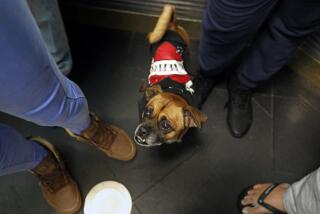Column: The nature lover of skid row: Homeless man comes to the rescue of a trapped bird
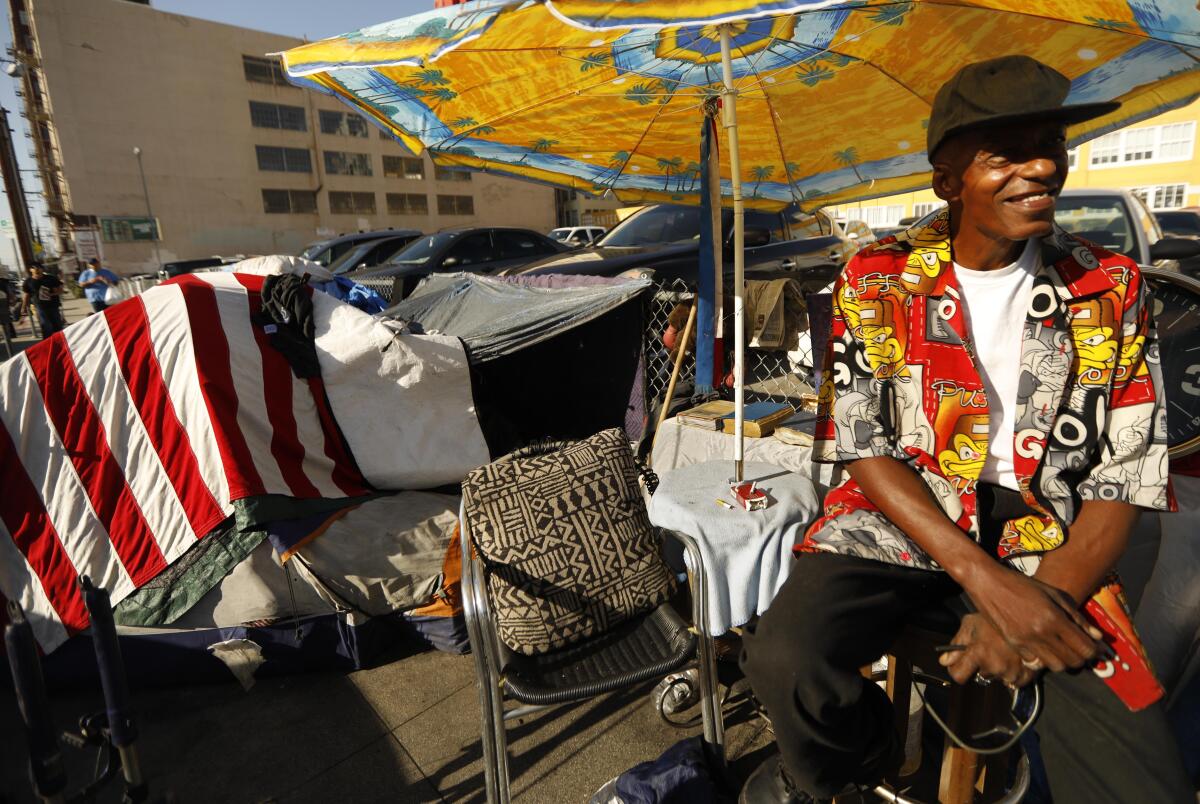
- Share via
I was walking south on Spring Street one day, on my way to work in downtown Los Angeles, when I saw a guy on a bicycle headed north.
He was half a block away but I could see that he was steering with one hand and holding something aloft in his other hand. When he drew closer, I saw a dark tuft on a gray towel that he held aloft, as if he were carrying something on a tray.
I had just passed Downtown Los Angeles Veterinary Services and wondered if the man was taking an injured animal to the vet. Sure enough, he pushed through the door, and I followed him inside to see what was up.
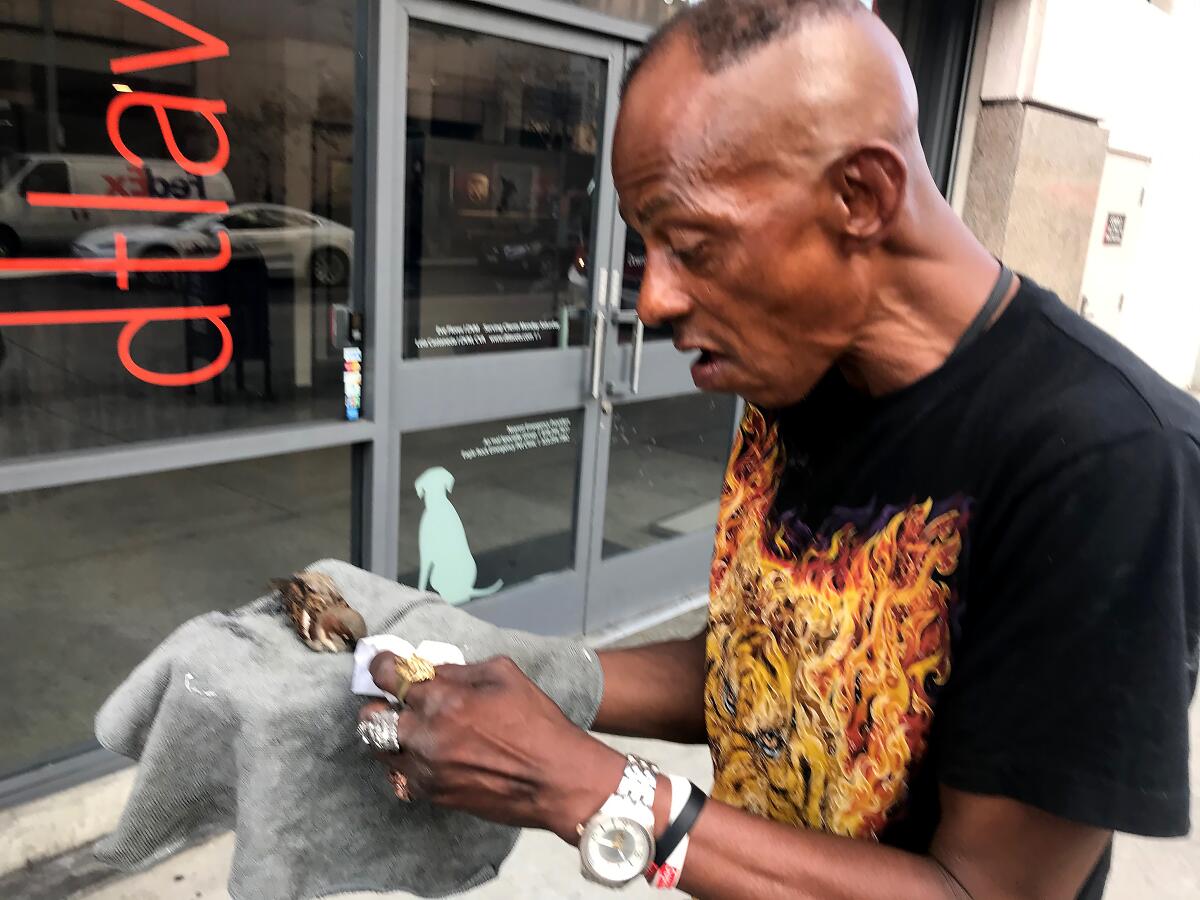
The animal, sitting forlornly on the towel, was a house sparrow. The man, whose name was Brian Cook, told the receptionist the bird was covered in glue, and he asked if someone could help. The receptionist said wild animals were not treated there, but he brought out some wet paper towels for Cook.
Cook stepped outside and went to work on the bird. He told me he was homeless and lived in the flower district on the edge of skid row, and he had found the bird stuck inside a glue trap outside his tent that morning. He’d put the trap there to keep rats from getting in during the night, a common practice on the streets.
I don’t know if sparrows have expressions, but this one looked sad, or shocked, or maybe just scared. Glue covered feathers on both sides of its body. The glue was heaviest on its left side, and its feet seemed glued to the towel.
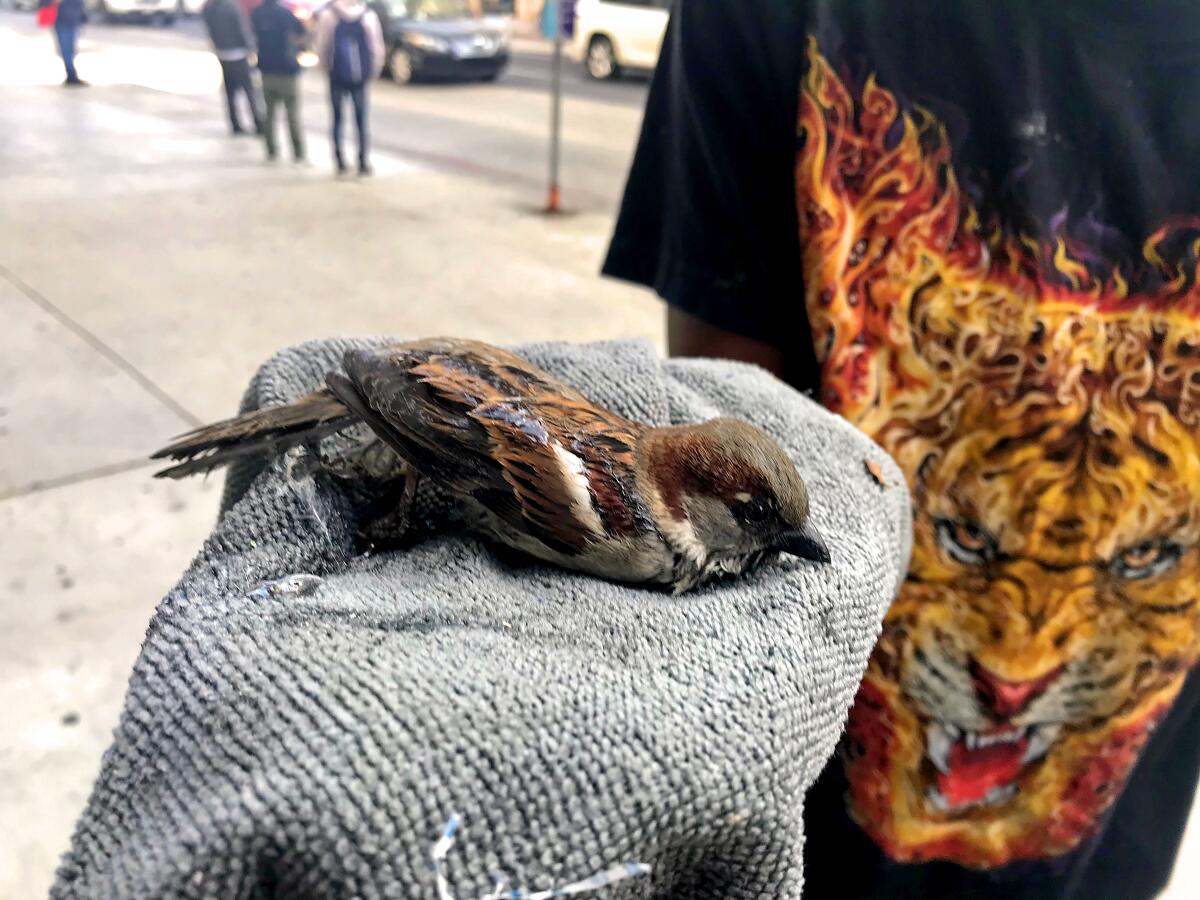
“I’m a nature lover,” said Cook, 59, who told me he grew up in Washington, D.C., and used to go look at wildlife at the Kenilworth Park & Aquatic Gardens.
Despite Cook’s efforts, the glue wasn’t coming off. A veterinary assistant named Daisy Valdez came out and told Cook she’d bring the bird inside and try to clean it up. Valdez said it’s not uncommon for homeless people to bring in wounded pigeons and other birds. She told Cook that if the sparrow recovered, it would be set free.
Cook told me he was known as “Old School” and had lived in the flower district for about five years. He said he was a computer technician by trade and a singer by avocation.
He also told me he had once picked up a pigeon that got hit by a car, and he nursed it back to health. The pigeon later flew back to him, he told me, and he suspected Freddie would come home, too.
“They’ve got great sonar,” Cook said.
On my way home that night, I stopped at the vet to check on the bird, and a medical technician named Axel Embriz said he had managed to get all the glue off with mineral oil. But the bird was having trouble flying, so a colleague took it to the Humane Society of Pasadena.
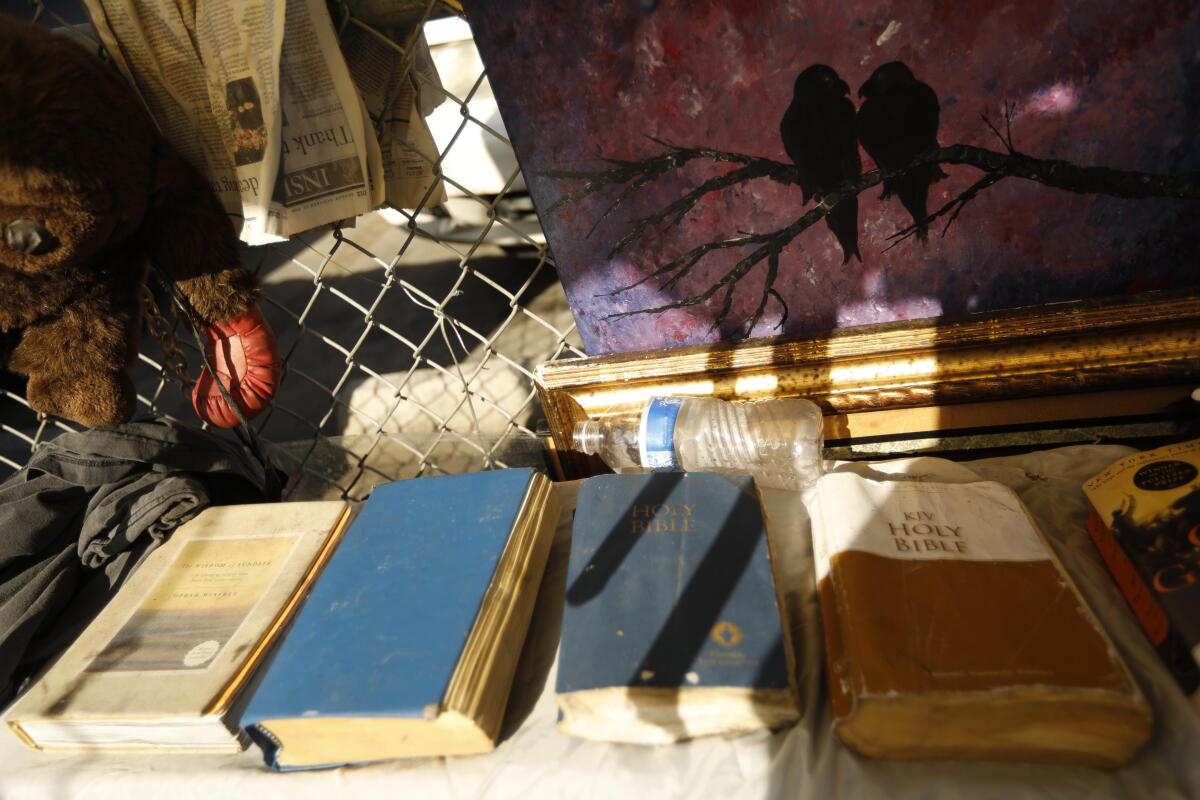
Two days later, I went to the Humane Society to see about the bird. But Jack Hagerman, vice president for communications, checked the log and said there was no record of a bird arriving from downtown Los Angeles on Nov. 12. Six birds had been brought in that day, but they were all from either Pasadena, South Pasadena or Arcadia.
The Humane Society of Pasadena is a great place to adopt a dog or a cat, but it also has a wildlife division for sick and injured animals. In 2018, Hagerman said, 5,302 wild animals were brought in, and 3,370 were alive. Field officers brought in most of the animals, but another 1,500 — including birds, squirrels and possums — were brought in by civilians.
OK, but what happened to the sparrow?
“There’s an update,” Jamie Pulido, a receptionist at the downtown vet office, said when I called.
He put his colleague Lisa Flores on the phone. Flores lives in Pasadena, so when she got off work on Nov. 12, the bird, which had been named Freddie by the veterinary staff, was placed in a cat carrier and Flores drove him to the Humane Society.
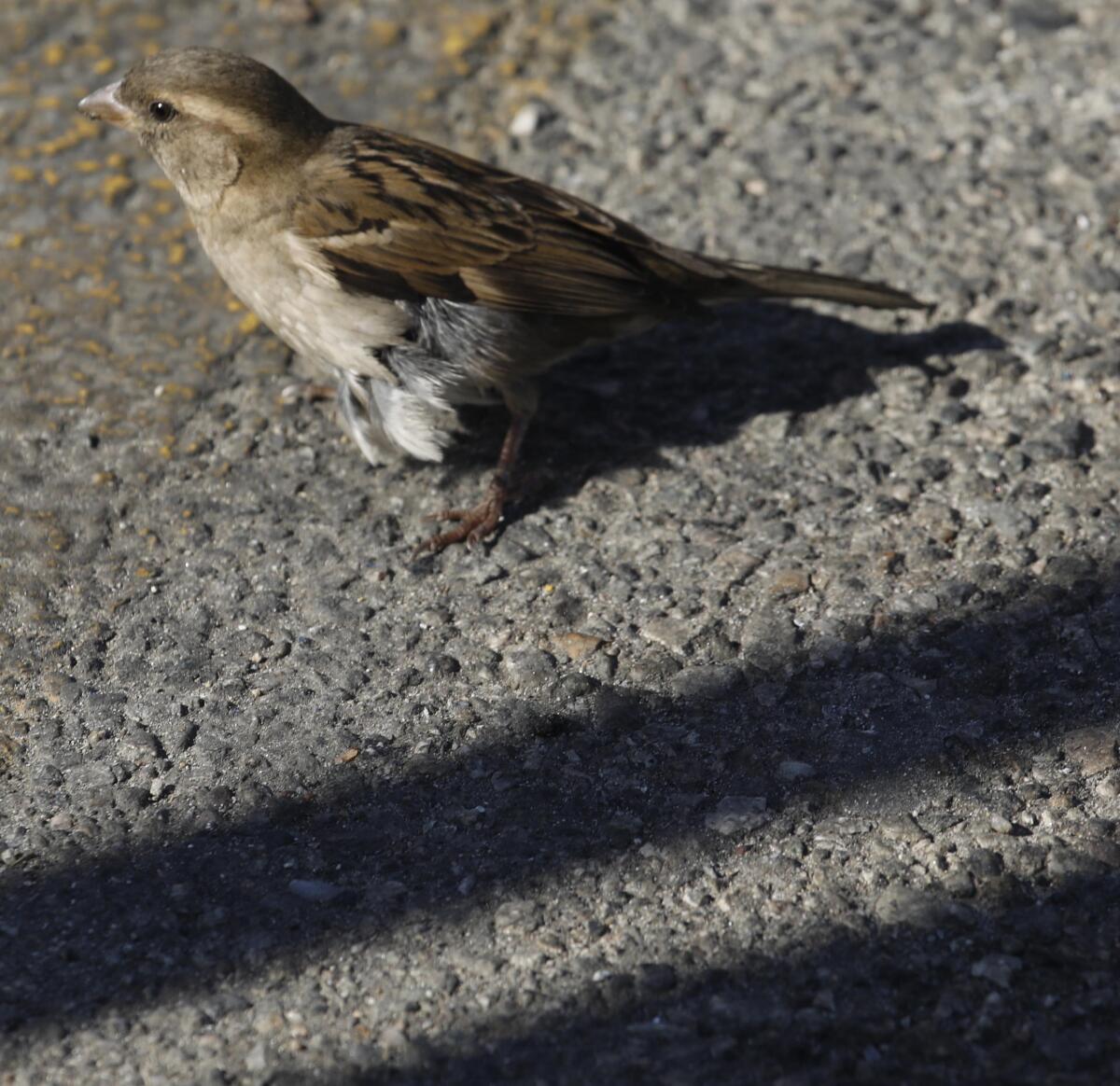
“He was chirping on the way there,” said Flores, who took that as a good sign.
At the Humane Society, a staff member came out with a cage.
But Freddie was tired of being held captive by then. Flores said that as they tried to transfer the bird into the cage, he made a break for it.
“He got out and kind of hop-flew away,” said Flores.
Freddie went straight for a bush and disappeared into it. Flores said it seemed that the sparrow was OK, and it had flown, if only a short distance. So rather than further traumatize it by trying to dig it out of the bush, it seemed best to let Freddie take things from there.
I went to see Cook a few days later and he was pleased to know Freddie had taken flight. He said, once again, that he expected the bird to return at some point.
Cook sleeps on a street where he’s known for taking a broom and keeping the sidewalks clean. Mario Gallardo, who manages a nearby building, said Cook sometimes empties the trash and keeps an eye on the building at night.
Salvador Davalos, who works across the street at a flower distributorship, said Cook earns a few bucks by helping customers carry flowers to their vehicles. He said Cook once joined him on top of a building and helped calm a woman who was threatening to jump.
Cook drapes an American flag over his tent, and three Bibles were neatly arranged on a table under a yellow umbrella on the day I visited him there. He told me he had been diagnosed with bipolar disorder and has had bouts of depression and brushes with the law, but that he was “more sober than I used to be.” An apartment building is going up a block away, and Cook said he wishes he could live there, but he hasn’t heard from his homeless outreach worker in a while.
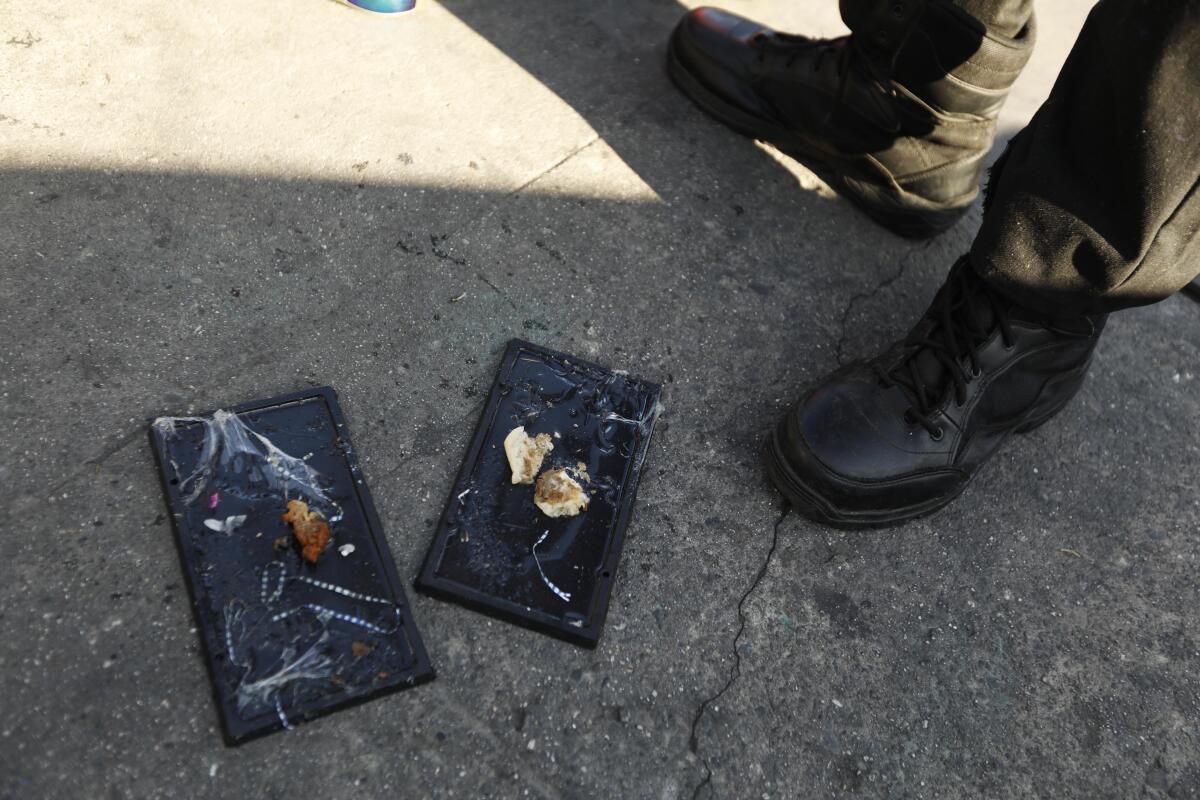
He showed me a trap like the one Freddie got caught in. You put glue in a shallow tray and add some peanut butter, and that does the trick. Cook said he had caught and disposed of 40 or 50 rats using the method. I went to the nearby store where he buys the traps, and a clerk told me the item is a big seller.
“We cannot coexist with rats in this city,” said Cook. He may be a nature lover, he said, but he was once bitten in the ear by a rat, and he’s got to protect himself and his food.
Still, he said, “I felt bad about the bird because it was my trap.”
Cook said he had been attacked recently by a man with a knife, but survived without major injuries. He said he saved the bird because he owed God one, for saving him.
I told Times photographer Genaro Molina that Cook was a singer, and that was all the prompting the bird man of skid row needed.
“Oh, my love, my darling,” he sang, covering the Righteous Brothers in fine fashion, “I’ve hungered for your touch …”
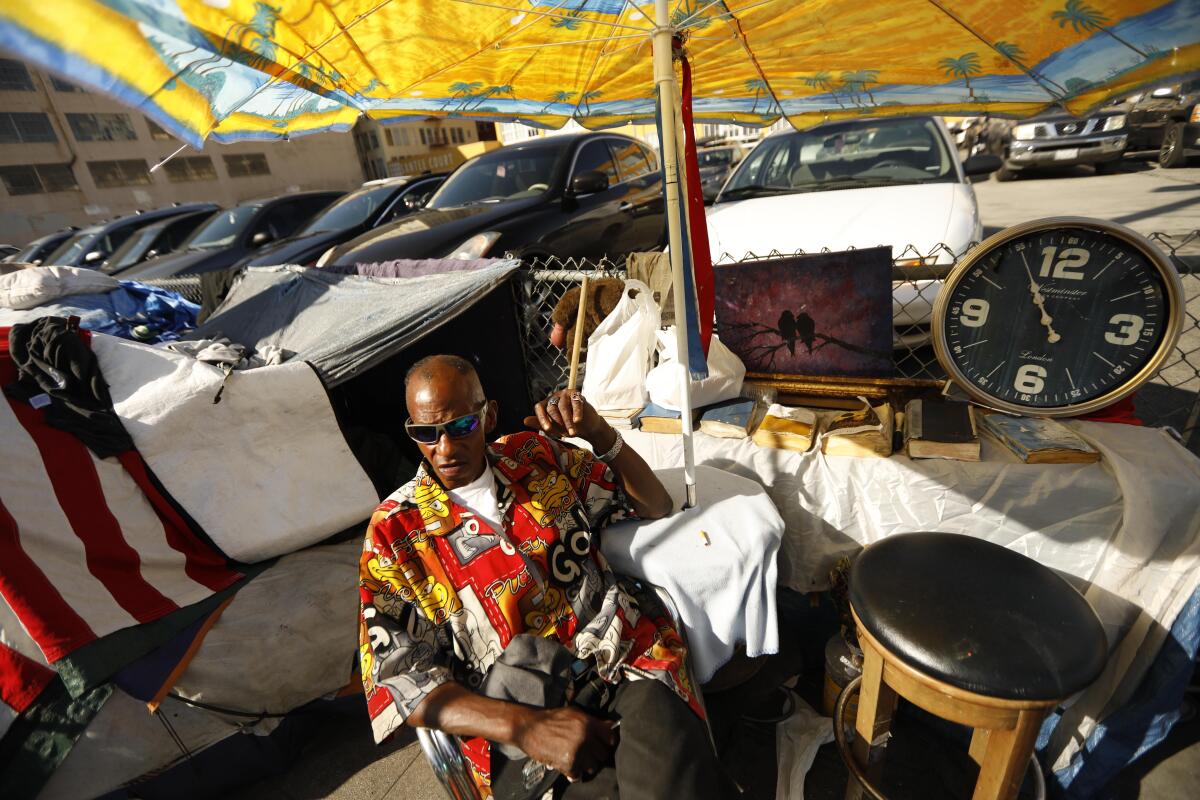
After I left, Molina later told me, a bird had dropped by, and Cook was sure it was the rescued sparrow because of a disturbed tuft of feathers on its left side — where a big glob of glue had been on the rescued bird. But is it even possible for a bird to find its way home from several miles away?
“House sparrows are certainly capable of traveling that distance … and quite a bit more,” said Kimball Garrett, ornithology collections manager at the Natural History Museum of L.A. County, in an email. Garrett said birds have natural GPS systems and use landmarks, sun position, magnetic fields and other cues to get where they want to go.
But he said there are lots of house sparrows in downtown Los Angeles, and they “basically all look alike.”
We’ll never know the truth. But in a city that can seem harsh and unredeeming at times, I for one am choosing to believe that Freddie has taken full advantage of his second chance and that, wherever he flew, he’s living the high life.
More to Read
Sign up for Essential California
The most important California stories and recommendations in your inbox every morning.
You may occasionally receive promotional content from the Los Angeles Times.



